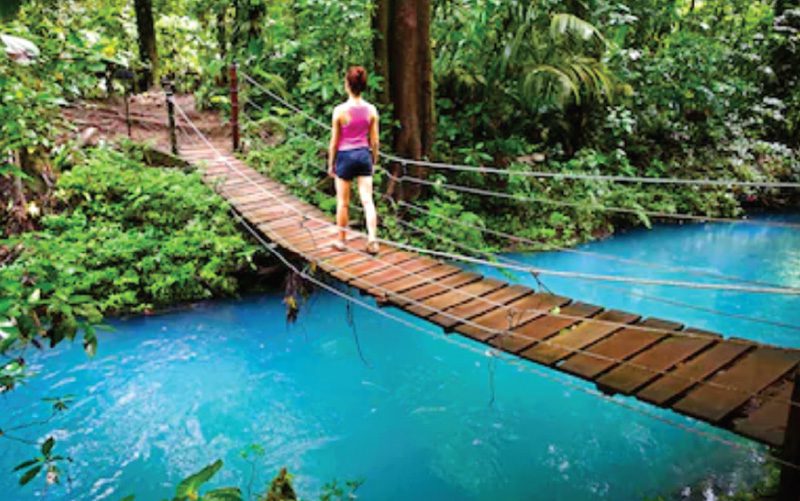Río Celeste Costa Rica: They say that when God finished painting the sky, he washed his paintbrushes in the Río Celeste Waterfall , giving this spectacular river in northern Costa Rica its unique sky blue color.
The real explanation is a bit more complicated, but there’s no question the effect is divine. Río Celeste Waterfall is the centerpiece of Tenorio Volcano National Park, between Rincón de la Vieja and Arenal, and it makes for one of the greatest hikes in Costa Rica.
Two rivers of normal color,
greenish-brown, collide and
produce the shocking blue,
And of course the highlight:
the Río Celeste Waterfall
From the entrance, which is a half-hour’s drive down an unpaved road from Bijagua, you enter the virgin rainforest on a well-maintained if sometimes muddy trail. Pretty soon there’s a turnoff to the left to descend the long stairs to the Catarata Río Celeste, a fabulous waterfall spilling into an aquamarine pool. You’re not supposed to climb the rail to get in the water, though there is a hike from elsewhere to the base of the fall.
Climbing the stairs back to the top and continuing on, you’ll come to a mirador, a lookout with views of Tenorio Volcano and sometimes even Lake Nicaragua. Mountaintops here are usually shrouded in clouds, and the best time to visit is in the dry season, from December to May. The main reason to consider the season is that runoff from heavy rains sometimes turn the blue river brown for a while, though it always turns blue again eventually.
Farther along is the Laguna Azul, a wide, tranquil and usually very blue stretch of the river. Borbollones, “bubbling place,” features an underwater hole in the lake that vents volcanic gases, making it look like the water is boiling.

And then there’s the scary little suspension bridge, a very crude job with nothing but planks wide enough to walk on and a rope to grab onto.
On the other side is Los Teñidores (“dyers’ shop”), where the mystery of the blue water is solved at last. Here you see where two rivers of normal color, greenish-brown, collide and produce the shocking blue.
A sign explains that suspended particles in one of the rivers called aluminosilicates lay down a visible line of white sediment on the bottom when they collide with the other river.
Immediately downstream from here, these particles float into the current at just the right sizes and with the right chemical properties to reflect the spectrum of the sun in only blue.
From here you turn around and retrace your steps, as there is only one trail with no loops — so you can’t get lost, and you don’t need a guide. It takes two or three hours to walk in and out, or longer if you face heavy rain and thick mud.
There are some nice lodges in the area if you want to spend the night, but many people choose to make Río Celeste a day trip from Arenal or elsewhere. There are few attractions or trails at the national park other than Río Celeste, so after you’ve done the main event, you may want to hit the road to your next destination.
Ecotourism in Costa Rica: Sustainable Tourism
Ecotourism Pioneer: Rafael Gallo – Ríos Tropicales
The Osa Peninsula
Ecolodges in Costa Rica
Ecotourist Dream: Road Trip SarapiquíRincon de la Vieja – Things to do
4×4 Lake Arenal – road to El Castillo
Lucky Lovers Leap into an adventure of a lifetime
Lake Arenal – Lost Canyon Adventure
Gone Fishing: worst day fishing beats the best day working
Seven Days in Costa Rica: Arenal, Dominical and More
Lake Arenal: Safari River Float is a slow boat to paradise
Gone Sailing in Guanacaste Costa Rica
Cocos Island, Costa Rica’s treasure
Stand Up Paddle boarding SUP
ATV Tours, Take the road not taken
Deep Sea Fishing, Fun and Flamingo Costa Rica
White water rafting in Costa Rica
Scuba Diving in Costa Rica
Costa Rica Combo Adventure Parks
Authentic Costa Rica: What to do in rural Bijagua
Blue River Resort and Hot Springs






